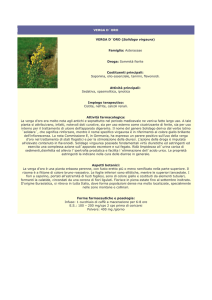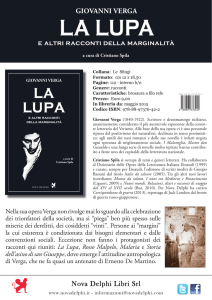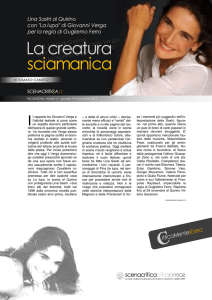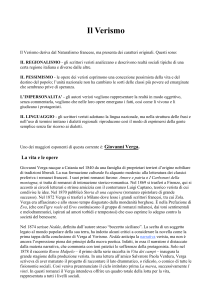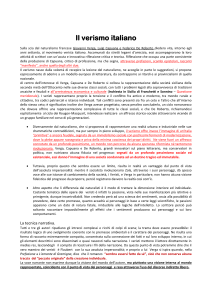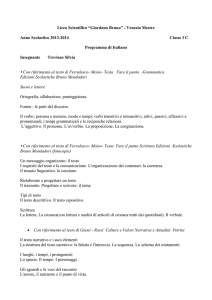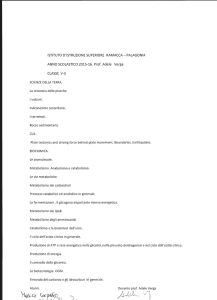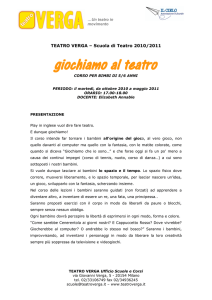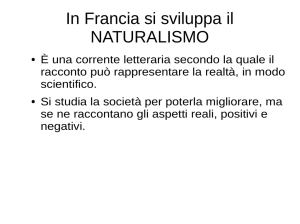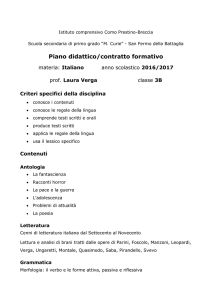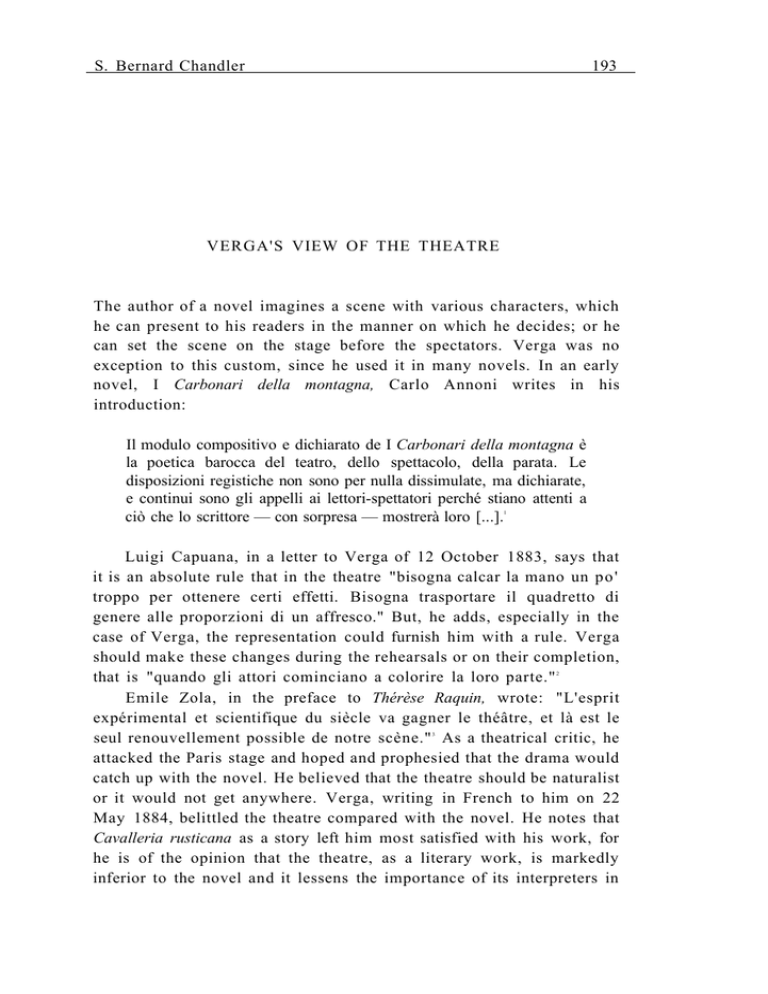
S. Bernard Chandler
193
VERGA'S VIEW OF THE THEATRE
The author of a novel imagines a scene with various characters, which
he can present to his readers in the manner on which he decides; or he
can set the scene on the stage before the spectators. Verga was no
exception to this custom, since he used it in many novels. In an early
novel, I Carbonari della montagna, Carlo Annoni writes in his
introduction:
Il modulo compositivo e dichiarato de I Carbonari della montagna è
la poetica barocca del teatro, dello spettacolo, della parata. Le
disposizioni registiche non sono per nulla dissimulate, ma dichiarate,
e continui sono gli appelli ai lettori-spettatori perché stiano attenti a
ciò che lo scrittore — con sorpresa — mostrerà loro [...].
1
Luigi Capuana, in a letter to Verga of 12 October 1883, says that
it is an absolute rule that in the theatre "bisogna calcar la mano un po'
troppo per ottenere certi effetti. Bisogna trasportare il quadretto di
genere alle proporzioni di un affresco." But, he adds, especially in the
case of Verga, the representation could furnish him with a rule. Verga
should make these changes during the rehearsals or on their completion,
that is "quando gli attori cominciano a colorire la loro parte."
Emile Zola, in the preface to Thérèse Raquin, wrote: "L'esprit
expérimental et scientifique du siècle va gagner le théâtre, et là est le
seul renouvellement possible de notre scène." As a theatrical critic, he
attacked the Paris stage and hoped and prophesied that the drama would
catch up with the novel. He believed that the theatre should be naturalist
or it would not get anywhere. Verga, writing in French to him on 22
May 1884, belittled the theatre compared with the novel. He notes that
Cavalleria rusticana as a story left him most satisfied with his work, for
he is of the opinion that the theatre, as a literary work, is markedly
inferior to the novel and it lessens the importance of its interpreters in
2
3
S. Bernard Chandler
194
the interest of a work of art. The success bursts out amid the
astonishment of the actors, and those who have applauded Cavalleria
rusticana as a play feel a kind of delusion in reading it. Yet, Verga
says, he had wished to write an essentially theatrical work. The
brothers De Goncourt had attacked the theatre on 10 January 1861: "le
théâtre est un moyen de peinture grossier, sans possibilité d'observation
vraie et fine, d'intime histoire d'une société."
In a letter to Capuana of 7 July 1885, Verga discusses the drama.
He questions the violability of dramatic convention; he does not
recognize any other theatrical necessity than the unity of time and place;
all that the author has passing under your eyes can really pass under
them and can happen in that period within the realms of the theatre.
Where are the limits of the scenic action? Up to what point can original
creation, intelligent execution, and the education of the public arrive?
He imagines a public of ten persons:
4
5
e vedo la collaborazione intima che ne dovrebbe risultare fra autore
attori e spettatori, la impressione sottile e immediata, la comprensione
assoluta che fa il successo. Ma in quelle condizioni soltanto badaci
bene.
6
Verga continues his attack on the theatre in a letter to Salvatore Di
Giacomo on 21 November 1888. He says that Di Giacomo is absolutely
right in his statement that the theatre is an inferior form of art; here
among the public and the press, with rare exceptions, is it possible for
the success of the theatre: "abbandonandolo alla genìe di mestiere e ad
artisti che devono preoccuparsi anzitutto della cassetta." He changes his
viewpoint when writing to Felice Cameroni on 20 April 1890. The
theatre is a serious affair; upper and lower classes are spectators:
"Ahimè! mi tenta ancora il sogno di questa forma dell'arte comunicativa
ed efficacissima, la realizzazione di un pubblico intelligente e di una
collaborazione perfetta tra autore e comici."
Verga tells Domenico Oliva on 21 November 1904, that the
Antologia would publish in December his comedy Dal tuo al mio and
he wishes to give to the reader the artistic impression which he would
have given to the spectator: "In altri termini fare lo stesso un p o ' da
attore e da scenografo, rimpolpando il dialogo con quel pochissimo che
basta a presentare la commedia sotto forma di romanzo. Certo quella del
teatro è opera d'arte inferiore." Verga informs Edouard Rod on 22
February 1905 that, for the publication of Dal tuo al mio, he has given
7
8
9
S. Bernard Chandler
195
it the form of a novel which he thinks is more interesting in the
reading. On 22 May 1905, however, Verga tells Rod that he is not
satisfied with the narrative form and prefers to publish it in its original
theatrical form; he believes that M. Brunetière is basically right that the
artistic work will be better judged in the original form in which it was
conceived.
Siro Ferrone, in his book Il teatro di Verga, deals with the novel
and the theatre. For example, Verga lacked understanding of the play
Dal tuo al mio and therefore: "Tornava al romanzo per una correzione
del copione che riducesse le tentazioni di una lettura prevalentemente
'sociale,' a vantaggio di un rapporto autore-lettore 'in diretta
comunicazione'." Ferrone had explained in the preface:
10
11
12
13
Nel romanzo l'adeguazione all'oggetto reale è del resto garantita
proprio dal naturale, rigoroso dominio sulla pagina scritta; mentre il
teatro gode già, per sua natura, di una vistosa autonomia nei confronti
dello scrittore e perciò Verga esita ad accentuarla.
14
Gaetano Mariani, in Ottocento romantico e verista, includes a
section on Il teatro di Verga of 1953. He describes Verga's remarks
on Dal tuo al mio, which Verga published as a short story, and outlines
the differences between writing for a reader and a spectator. In fact, as
Mariani notes, Verga had replied to an inquiry from Ugo Ojetti in 1894:
15
Ho scritto pel teatro, ma non lo credo certamente una forma d'arte
superiore al romanzo, anzi lo stimo una forma inferiore e primitiva,
sopra tutto per alcune ragioni che dirò meccaniche. Due
massimamente: la necessità dell'intermediario tra autore e pubblico,
dell'attore; la necessità di scrivere non per un lettore ideale che
avviene nel romanzo, ma per un pubblico radunato a folla così da
dover pensare a una media di intelligenza e di gusto, a un average
reader, come dicono gli inglesi. E questa media ha tutto fuori che
gusto e intelligenza; e se un poco ne ha, è variabilissima col tempo
e col luogo.
16
Mariani indicates that Rose caduche had a notable importance in
the development of Verga's art, since it was written with the evident
purpose of giving life to the theatre in the world of gallants and in the
society of the salons which Verga, sometimes belonging to them
sentimentally, but more often ironically, had represented in Eva, Tigre
reale and Eros. Mariani writes that Verga reproduces in his theatrical
S. Bernard Chandler
196
work passages which were proper to the story, contributing sometimes
only some questionable transformations. The theatre of Verga, like the
narrative from which it issues and to which it remains bound, comes
from his naturalist experience.
Verga adapted the novel and the short story to his concept of their
composition. He could be the independent writer or a member of the
society of his characters and write in a manner that revealed him as
17
such. He applied verismo to his style of writing. He told Rod on 4
April 1905, in regard to Dal tuo al mio, that he had not wished to write
a polemic, but a work of art:
Se il racconto ο il teatro descrivendo la vita qual è, hanno una
missione umanitaria, io ho fatto la mia parte in prò degli umili e dei
disereditati assai prima che tanti altri parlassero di socialismo e di
lotta di classe e seminassero l'odio in nome dell'umanità.
18
S. BERNARD CHANDLER
University of Toronto,
Toronto, Ontario
NOTES
1
I Carbonari della montagna. Sulle lagune, intro. Carlo Annoni (Milan: Vita
e Pensiero, 1975), p. 24.
Gino Raya, Carteggio Verga-Capuana (Rome: Edizioni dell'Ateneo, 1984),
p. 207.
Teatro verista, ed. Vittorio Bracco, pref. Umberto Bosco (Brescia: Editrice La
Scuola, 1973), p. 9.
Lettere sparse, ed. Giovanni Finocchiaro Chimirri (Rome: Bulzoni, 1979), p.
163.
Journal. Mémoires de la vie littéraire, Tomo IV, 1860-61 (Monaco: Les
Editions de l'imprimerie nationale de Monaco, 1956), p. 151.
Raya, op. cit., p. 241.
Giovanni Finocchiaro Chimirri, Postille a Verga. Lettere e documenti inediti
con XII tavole inedite di Verga fotografo, II edizione accresciuta (Rome:
Bulzoni, 1972), p. 86.
Lettere sparse, op. cit., p. 244.
Ibid., p. 365.
Lettere al suo traduttore, ed. F. Chiappelli (Florence: Le Monnier, 1954), p.
2
3
4
5
6
7
8
9
10
S. Bernard Chandler
197
203.
Ibid., p. 211.
Siro Ferrone, Il teatro di Verga (Rome: Bulzoni, 1972).
Ibid., p. 303.
Ibid., p. 10.
Gaetano Mariani, Ottocento romantico e verista (Naples: Giannini, 1972). The
section on the theatre of Verga is on pp. 381-400.
Ibid., p. 381, n. 1.
The most recent treatment of Verga as novelist and short story writer is
Angelo Marchese, "Narratore, personaggi e autore implicito nelle 'Novelle
rusticane' di Verga," Otto/Novecento 19, No. 2 (marzo-aprile 1995), 5-71.
Lettere al suo traduttore, op. cit., pp. 208-9.
11
12
13
14
15
16
17
18

